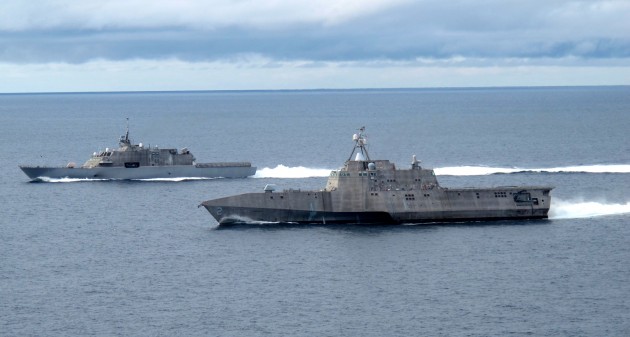
The two Littoral Combat Ship variants, LCS-1 Freedom (far) and LCS-2 Independence (near).
WASHINGTON: Talk about timing. As Congress gears up to grill Navy officials on the much-criticized Littoral Combat Ship program, the fleet’s first LCS suffered yet another power outage that “briefly” shut down its engines near Singapore, where the USS Freedom recently deployed for its first foreign tour. [Click here for the Navy’s detailed official explanations]. Freedom had three prior electrical outages in March.
“Sydney, this is ludicrous,” fumed naval historian and LCS critic Norman Polmar. “It’s a relatively simple ship and we can’t get it right. There’s something wrong with the whole approach, the whole program, and it needs to be reviewed at a much higher level,” he said, preferably by a blue-ribbon panel of experts from outside the Navy Department: “It can’t be left in the hands of the people running the program, Navy and civilian.”
“I hate to tell you ‘we told you so’,” said Ben Freeman, who led the charge against LCS at the Project On Government Oversight, POGO. (Freeman is now the national security advisor at Third Way, a centrist Democratic thinktank). “We were talking about these problems two years ago, and we were told at the time …. all this has been dealt with, from the equipment failures to the cracking.”
The Littoral Combat Ship has come under heavy fire for years from two different directions. Good-government watchdogs, like Freeman, say the program has been badly managed, with major cost overruns and quality-control problems, from hull cracking on the Lockheed Martin/Marinette Marine Freedom variant to corrosion on the General Dynamics/Austal Independence. (The two contractors are building distinctly different designs).
Naval traditionalists, like Polmar, say that even if you can get the ship to work, the basic design is a bad idea, a vulnerable and undergunned warship that provides far less combat power per dollar than foreign designs in the same weight class. The Navy, for its part, argues that it has turned LCS’s early problems around and that the ships’ unusual designs will open bold new possibilities for naval warfare.
Just two months ago, BreakingDefense was leaked a draft LCS report from the Government Accountability Office that said, among other criticisms, that the Navy had only 10 percent confidence in its own estimates of the warships’ long-term cost. GAO is rolling out a major LCS study this week – almost certainly the final version of the same report. The Navy will brief journalists on the GAO report tomorrow, while the seapower subcommittee of the House Armed Services Committee will grill Navy officials about it at a hearing Thursday. We’ll keep our readers updated, but already it looks like an ugly week for LCS.
[Updated 2pm Wednesday : The Navy has announced that the ship’s crew and support technicians ashore have repaired two onboard generators that overheated, and the USS Freedom is now back underway and training with US and Royal Singapore Navy vessels.]
Major trends and takeaways from the Defense Department’s Unfunded Priority Lists
Mark Cancian and Chris Park of CSIS break down what is in this year’s unfunded priority lists and what they say about the state of the US military.


























